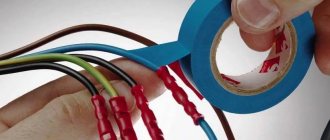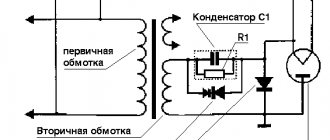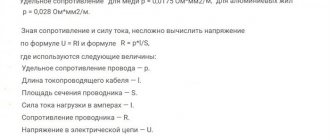Need to ground myself
An equally important reason why the bird is not shocked is the lack of grounding. What exactly is an electric shock? This is the moment when charged particles pass through a living being if it completes a circuit, becoming a conductor for a while.
For example, a person can easily stand on a rubber mat and insert a nail into a socket, with virtually no risk of receiving an electric shock (but it’s better not to do this at home!!!). But as soon as he touches some metal object with his hand, charged particles instantly rush towards this object, and through a living body, often leading to its death.
Do birds have grounding? Of course no! They just sit on one wire and there is nowhere for the current to go through them. What happens if grounding occurs? Of course, the bird will die instantly - after all, a discharge of thousands or even tens and hundreds of thousands of volts will pass through it. Most often this happens with large birds - eagles and others. But they don’t just sit on the wires, holding them tightly with both paws - in this case, nothing will probably happen to them. But if a proud eagle sits on a wire, holding onto it with one paw, and touches, for example, a metal support with the other or its wing, it will create an additional circuit through which the current will immediately flow. The consequences for the bird will be very sad.
However, in recent years, in order to avoid this, several meters of wire in the immediate vicinity of the support are covered with special insulators. Sitting on them, the bird can try to close the circuit all day long - this will not harm it.
Birds sit on wires and get hit by a high voltage breakdown
“Hey, darling, what’s wrong with you?!” – Bird... it’s a pity... (From the film “Prisoner of the Caucasus”)
The wire may carry very high voltage. So high that any creature on the wire, with its small size, reduces the distance between the wires. And then an electrical breakdown is possible.
Air is a poor conductor of electricity. So bad that wires located far apart from each other have no effect on each other. But still, air, albeit a little, conducts electricity.
This means that the closer the wires are located, the greater the likelihood that the electric current will pass directly through the air. The lightning effect occurs: a discharge of electricity in the atmosphere. This means that electric current has flowed through the air.
So, if a bird sits on a wire or on a pole, then with its body it shortens the distance between the wires or between the wire and the ground. The pillar is also a kind of continuation of the earth, for it is buried in the ground. And then, if the voltage is very high, the electric current will flow through the bird from one wire to another wire or into the ground, or into a pole buried in the ground.
We see such an unfortunate bird in the video above. As soon as the woodpecker sitting on the pole turned its head and thereby shortened the distance to the high-voltage wire by millimeters, a fatal discharge of electricity immediately occurred.
Why do birds sit on wires? In fact, they are taking a lot of risk by sitting on the wires. But they have no idea about it. There were no man-made electrical wires in nature, and birds do not have a generational memory of danger. This means that people should take care of them and prevent birds from landing in dangerous places. But such protection is, alas, not always and not everywhere.
A few words about potential difference
It would not be amiss to talk about the potential difference and the step voltage associated with it. But first things first.
What is tension? Another name for it is potential difference. For example, in simple sockets, which are found in every apartment and house, it is 220 volts. That is, on one contact the potential is 220 volts, and on the other - 0. That is why they are called “phase” and “zero”. As long as they are separated from each other, nothing happens - that is why the potential difference remains constant - 220 volts. But what happens if you close this circuit, for example, by plugging in a refrigerator plug? Of course, charged particles will run along the wire, start the motor and the lighting of the refrigerator, and only the unused voltage will go to “zero”.
In principle, a power line works in exactly the same way. Near the power plant, the voltage is simply enormous - thousands, and sometimes hundreds of thousands of volts. But at the opposite end there is zero. Of course, charged particles with enormous speed (the speed of light!) will rush from phase to zero, along the way launching all devices plugged into sockets - from light bulbs in entrances to huge factories. This is ensured by the potential difference at different ends of the power line. What does this have to do with the topic of our article? The most immediate thing - just be patient for a few more lines.
Now let's look at what step voltage is. This is the name for the difference in potential between the points connected by the legs of a person (or a bird, any animal). The greater the distance between the points, the higher the potential difference. This is why experts recommend that people who find themselves in an electric shock zone move in small steps and certainly not run.
This is also true for birds. If the potential difference at the beginning and end of a 1000-kilometer power line is 1 kV, then there is only 1 volt per kilometer. And if we take the distance between the birds’ legs to be about 5 centimeters, then the difference will be only 0.000005 volts. Of course, if the bird receives such a discharge, it will not even feel a slight tingling in its paws. Well, she won’t be able to put her paws wide enough to die from an electric shock, even if she wanted to.
What is more dangerous: electric voltage or electric current?
“...It’s not beer that kills people! Water is killing people!” (From the song to the film “It Can’t Be”, 1975)
Electricity is dangerous. One careless touch to a bare live wire and... It turns out that electrical voltage is dangerous for humans, as well as for any other living creature? Ah, not quite like that.
Electric current, not electrical voltage, is dangerous to humans. If voltage killed, then one shock from electrified clothes would have been enough for us.
The fact is that static electricity, which strikes us every now and then, has a very high voltage, judging by the standards of home electricity. The room outlet has 220 volts (220V for short). And static strikes with an electrical voltage of several tens or even hundreds of thousands of volts!
But static electricity has a very weak current. These are thousandths or even hundred thousandths of an ampere. Because electrostatic clothing has its own high electrical resistance, strong current cannot pass through it. In general, due to friction, you can get a high voltage, but at the same time you get a very small current.
A truly lethal electric current is 0.1 ampere (0.1A, for short). Such a current can pass through a person if the voltage in the electrical network is slightly higher than 36V. That is, 220V household voltage is truly lethal.
It turns out that the electrical resistance of the human body is approximately 360 ohms (abbreviated as 360 Ohms), or rather, a little more. Current is determined by Ohm's law, after which the value of electrical resistance is named. According to this law, current is the quotient of voltage divided by resistance: 36 V / 360 Ohm = 0.1 A
That is why in various mines, construction sites and other dangerous places where a person can accidentally touch wires, electric lighting bulbs with a rated voltage of no higher than 36 volts are hung. This voltage is still safe for humans. If higher, the electrical wires must be reliably insulated so that they cannot be touched by a person or any other living creature.
In general, it turns out that current kills, not voltage. But voltage without current and current without voltage are impossible. These are two units of measurement of one substance, which is electricity. Therefore, electricity is dangerous, as they say, by definition. No one should touch any wires. But for some reason birds can...
Horse accident
Speaking about step voltage, it is worth recalling one instructive incident that took place in Leningrad in 1928. It perfectly illustrates this physical phenomenon and has received its own name - Horse Crash.
This happened in the middle of a square lined with hexagons made of wood. There was a cast iron well, inside of which there was a 2 kV disconnector. Over time, the insulator simply cracked, causing the disconnector to hang a few centimeters from the wall. Probably, this would not have been noticed for a long time if it had not been for the rain.
After heavy rainfall, the wooden pavement became not only pliable, but also conductive. While people walked along it, nothing terrible happened. But when a heavily loaded cart passed near the well, the pavement surface buckled, causing the wire to short-circuit on the well, releasing 2000 volts to the environment.
People whose step was less than a meter simply received a relatively mild electric shock. But the horse pulling the cart was less fortunate. Firstly, her hooves were equipped with metal horseshoes that perfectly conduct current. Secondly, the distance between the horse’s legs was more than one and a half meters. As a result, the electric shock simply killed her on the spot. Moreover, this whole incident took no more than two seconds - after that the “automatic machine” worked.
What happened was able to interest people, including servants of the law - a horse patrol consisting of two policemen arrived at the place of the mysterious death of the animal. By this time, the duty officer at the substation checked whether everything was in order with the insulation and decided that the shutdown had occurred accidentally, and immediately turned on the current. As a result, people standing or walking in the square again received a small shock, but both police horses died on the spot.
By the way, exactly the same incident happened in our time in Great Britain. In Berkshire, there is a popular racetrack under which the underground cable finally leaked in 2011. Several horses also died due to the accident, but the people present were not injured.
"Personal protection"
There are several factors that explain why birds on wires are not electrocuted. Let's look at the biological ones first, although they are less significant. Firstly, there is a layer of keratinized scales on the flyers' paws. To some extent, they act as insulators, although rather weak ones. Secondly, birds are able to sense the strength of the electromagnetic field. If a power line produces a voltage of 500 kV, then birds simply avoid landing on it.
It is curious that birds preferentially choose insulated wires when landing. It is difficult to say whether this is another reason why birds do not get electrocuted on wires: perhaps it is simply more pleasant and convenient for them to rest their paws on the insulation. Although some scientists are of the opinion that this also triggers the protective sensitivity of flyers.
Why do birds sit on wires, despite the danger?
Since birds are still at risk of electrocution, and possibly (in most cases) death, why do they still land on the wires?
I found 3 obvious explanations for this:
- Protection from enemies. Sitting on the wire, the birds guarantee their safety almost 100%, because most enemies will not be able to reach them so high.
- The desire to build a nest. This reason has many similarities with the previous one. Wanting to protect their offspring from enemies, birds build their nests as high as possible.
- Ignorance of danger. And finally, the simplest explanation is that you and I know that wires are an unsafe place, and the birds have no idea about this.
By the way, scientists were able to prove that birds sense the electromagnetic field well, which is why they rarely land on high-voltage power lines.
Birds and wires
There are cases in which birds have caused disruption to power lines. Such cases are few, but they do exist: birds carrying in their beaks a piece of material capable of conducting electric current caused a short circuit on the line. This is explained by the fact that the material (for example, wire) is a kind of bridge, a conductor, and when it comes into contact with the wire, current flows.
In order for a bird to actually get an electric shock, it is necessary to literally lie down on the insulators. At the same time, the size of the bird should be impressive. A large bird can cause an electrical circuit to form, which will have a detrimental effect on it.
People can also touch electrical wires, but only with the use of special equipment and techniques.
Why don't birds on wires get shocked? About technology and gadgets
How animals are protected from electric shock
To protect power lines, bird protection devices (BIDs) are installed on them, and during reconstruction or major repairs of power lines, the bare wire is replaced with an insulated wire (SIP).
There are many types of bird control devices. Some prevent birds from landing on power lines, others, on the contrary, are designed for safe landing, while others make the wires visible to birds. Nizhny Novgorod power engineers use insulating ROMs. These are polymer cases that cover the heads of power transmission line supports and part of the wire.
Bird protection device
ROMs are efficient. In 2022, Dront specialists, commissioned by the Ministry of Ecology, examined sections of power lines equipped with devices in the Kstovsky and Buturlinsky districts (a copy of the study is at the disposal of the editors). They did not find any dead birds nearby, while near supports without ROM sometimes several corpses can be found at once.
The obligation of power line owners to make their equipment safe for animals is enshrined in federal and regional laws:
— Law “On Animal World”. According to Article 28, legal entities are obliged to prevent the death of animals during the operation of communication and power lines.
— Russian Government Decree No. 997 of August 13, 1996. It states the obligation to install bird protection devices on power lines, poles and insulators, as well as to prevent the death of birds - on poles and from collisions with wires.
— Rules for the design of electrical installations , approved by the Russian Ministry of Energy. According to paragraph 2.5.36, in areas inhabited by large birds it is prohibited to use supports with pin insulators.
Expert opinion
It-Technology, Electrical power and electronics specialist
Ask questions to the “Specialist for modernization of energy generation systems”
Why birds don’t get shocked on wires More than half of Gazprom Transgaz Nizhny Novgorod’s electrical networks are equipped with ROMs; the company has been installing the equipment since at least 2010. Ask, I'm in touch!











